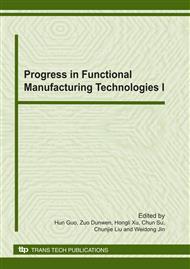p.155
p.161
p.167
p.173
p.179
p.185
p.192
p.200
p.206
Prediction Model of Surface Roughness for 2A70 Alloy Based on Orthogonal Test
Abstract:
Influencing rules of surface roughness for the work-piece by changing major milling parameters are studied when 2A70 alloy are cut by cemented carbide ball-end milling cutter cuts in high-speed. Primary and secondary influence order of test factors are found out through range analysis and variance analysis of test data according to the orthogonal test designed by the manufacture experience. Influencing tendency between milling parameters such as feed per tooth, back cutting depth, milling speed and line width and the roughness are obtained, a prediction model of aluminum alloy surface roughness is built up, surface quality of the product can be predicted and productivity can be analyzed.
Info:
Periodical:
Pages:
179-184
Citation:
Online since:
December 2010
Authors:
Price:
Сopyright:
© 2011 Trans Tech Publications Ltd. All Rights Reserved
Share:
Citation:


